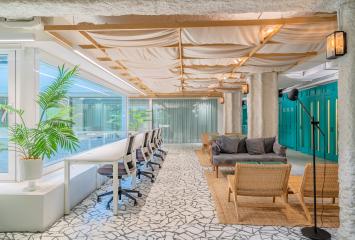Smart materials that promote office sustainability
Offices can no longer be indifferent to society's sustainability efforts. As indispensable parts of it, as engines of change, they must strategically adapt to consume fewer resources, limit their carbon footprint, and enhance the surrounding nature as much as possible. And technology is an extraordinary ally in achieving this. Specifically, so-called smart materials, integrated solutions that reduce the efforts people need to make to protect the environment while significantly optimizing results. Let’s get to know the most outstanding ones.
Smart glass
Smart glass can be installed in office windows to automatically adjust opacity or transparency depending on the time of day and the specific time of year. In this way, the office receives the amount of sunlight and heat it requires, resulting in smarter consumption of artificial lighting, heating, or air conditioning.
Thermochromic paints
Thermochromic paints are paints that change color in response to temperature. Thus, they manage to absorb or reflect sunlight as needed to provide a more comfortable environment. Their purpose is essentially the same as the aforementioned smart glass and can be applied to office walls to contribute to the resource economization we discussed earlier.
Smart flooring
Kinetic energy is the energy produced through movement. What smart flooring does, making it a great sustainability solution, is harnessing the energy released from the employees' movements to generate clean, renewable electricity that can subsequently be used to power the office's electronic or lighting devices.
Lighting sensors
Smart lighting sensors offer two main benefits. On one hand, by automatically adjusting based on environmental inputs, they reduce energy consumption within the office. On the other hand, by always facilitating that balance between human needs and the planet's needs, they provide an environment conducive to people's well-being.
Thermosolar tiles
Harnessing kinetic energy is an act of ecological awareness. Harnessing solar energy is as well. And that’s what installing thermosolar tiles in the office allows: these tiles are designed to absorb and retain the sun's heat during the day and release it gradually as night falls to keep the office at an optimal temperature throughout the day.
Management systems
The quality of managing both energy and waste produced by the office daily largely determines the sustainability level of these buildings. Fortunately, scientific and technological advances have made it possible to develop smart systems for such management, which monitor and control consumption and limit environmental impact.
Self-repairing materials
Materials that change their physical properties to adapt to certain stimuli. Nanotechnology coatings. Software based on artificial intelligence and machine learning. Solutions like these facilitate the self-repair of technologies present in the office, thereby reducing downtime. They will be the protagonists of the office of tomorrow.

